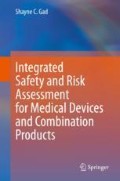Abstract
While medical devices have been derived and used since at least ancient Egypt, means of verifying their biologic safety to patients (biocompatibility) and regulations requiring and governing such pre-use evaluation (testing) are much more recent. Less than a century has seen the modern approach, with testing dictated by type, and duration, of patient contact are much more recent. Such requirements first arise in the 1960s due to concerns with materials migrated from a device into the patient body. The science and complexity of testing involved are continuously evolving (accelerated by concerns as to the safety of silicones in the late 1980’s) and have also served to drive the growth of the medical device market (now nearly a third the size of the pharmaceutical market) and the innovations and complexity of devices and device/drug combinations.
Access this chapter
Tax calculation will be finalised at checkout
Purchases are for personal use only
References
APHIS. (1989). Animal and Plant Health Inspection Service, United States Department of Agriculture. Federal Register, 54(168), 36112–36163.
ASTM. (1990). Standardization in Europe: A success story. ASTM Standardization News, 38, February 1990, pp. 1–4.
Boutrand, J.-P. (Ed.). (2012). Biocompatibility and performance of medical devices. Cambridge: Woodhead Publishing.
Calley, D., Autian, J., & Guess, W. L. (1966). Toxicology of a series of phthalate esters. Journal of Pharmaceutical Sciences, 55(2), 158–162.
CDRH. (1992). Regulatory requirements for medical devices: A workshop manual. Rockville: Center for Device and Radiological Health, HHS Publication FDA 92–4165.
CFR. (1992). FDA’s policy statement concerning cooperative manufacturing arrangements for licensed biologics. Federal Register, 57, 55544.
Di Silvio, L. (Ed.). (2009). Cellular response to biomaterials. Cambridge: Woodhead Publishing.
European Committee for Standardization. (1991). CEN Annual Report 1991. Brussels.
FAO. (1991). Report of the FAO/WHO Conference on Food Standards, Chemicals in Food and Food Trade (in cooperation with GATT), Vol. 1, Rome, March 18–27.
FDA. (2016). ISO 10993-1. Biological evaluation of medical devices. Part1: Evaluation and testing within a risk management process. Department of Health and Human Services. Silver Springs, MD.
FDA. (1986). Tripartite biocompatibility guidance for medical devices. Rockville: Toxicology Subgroup of the Tripartite Sub-Committee on Medical Devices, Food and Drug Administration, Center for Devices and Radiological Health (FDA CDRH).
FDA. (2013). Good laboratory practice regulations: 21 CFR 58.1–58.219.
FDLI. (2013). Compilation of food and drug Laws, volumes I, II, III and supplement. Washington, D.C.: Food and Drug Law Institute.
Gad, S. C. (2001). Regulatory toxicology (2nd ed.). Philadelphia: Taylor & Francis.
Gad, S. C., & Chengelis, C. P. (Eds.) (1992) Animals Models in Toxicology. Marcel Dekker, New York. p. 884.
Gad, S. C., & Gad-McDonald, S. E. (2015). Biomaterials, medical devices, and combination products: Biocompatibility testing and safety assessment. Boca Raton: CRC Press.
Gad, S. C., & Schuh, J. C. L. (2018). Points to consider for toxicologic pathologists evaluating biomaterials and medical devices. Toxicologic Pathology, 46(4), 366–371.
Gad, S. C., & Taulbee, S. (1996). Handbook of data recording, maintenance and management for the biomedical sciences. Boca Raton: CRC Press.
Greco, R. S. (1994). Implantation biology: The host response and biomedical devices. Boca Raton: CRC Press.
Hutt, P. B. (1989). A history of government regulation and misbranding of medical devices. Food Drug Cosmetic Law Journal, 44(2), 99–117.
ISO. (1990). ISO 9000 international standards for quality management vision 2000—A strategy for international standards’ implementation in the quality arena during the 1990s (2nd ed., compendium). Brussels: EEC.
Lang, L. A. (1996). A review of latex hypersensitivity. Toxic Substance Mechanisms, 15, 1–11.
Lewis, R. J. (2012) SAX’S Dangerous Properties of Industrial Materials, 12th Ed., Wiley-Interscience, Hoboken, NJ.
MAPI. (1992). The European community’s new approach to regulation of product standards and quality assurance (ISO 9000): What it means for U.S. manufacturers. MAPI Economic Report ER-218.
MDDI. (2013). Industry snapshot. Medical Device & Diagnostics Industry, July 2013, 52–62.
Nocera, J. (1995). Fatal litigation. Fortune, October 23, 1995, 60–82.
Nugent, T. N. (1994). Health care products & services basic analysis. New York: Standard & Poor’s Industry Surveys.
O’Grady, J. (1990). Interview with Charles M. Ludolph. ASTM Standardization News, 26, February, 1990, pp. 3–6.
Regulatory Affairs Focus. (1996). European update. Regulatory Affairs Focus, 1(4), 8.
Sivin, I. (1993). Another look at the Dalkon Shield: Meta-analysis underscores the problems. Contraception, 48, 1–12.
Spizizen, G. (1992). The ISO 9000 standards: Creating a level playing field for international quality. National Productivity Review, 11(3), 331–346.
The Wilkerson Group. (2013). Forces reshaping the performance and contribution of the U.S. medical device industry. Washington, D.C.: Health Industry Manufacturers Association.
USP. (2006). The United States pharmacopoeia <88>, biological reactivity tests, in vivo, USP 29. Rockville: United States Pharmacopoeial Convention.
USP. (2013). The United States pharmacopoeia, 36 revision. Rockville: United States Pharmacopoeial Convention.
Author information
Authors and Affiliations
Corresponding author
Rights and permissions
Copyright information
© 2019 Springer Nature Switzerland AG
About this chapter
Cite this chapter
Gad, S.C. (2019). Introduction: History and Where We Are Headed. In: Integrated Safety and Risk Assessment for Medical Devices and Combination Products. Springer, Cham. https://doi.org/10.1007/978-3-030-35241-7_1
Download citation
DOI: https://doi.org/10.1007/978-3-030-35241-7_1
Published:
Publisher Name: Springer, Cham
Print ISBN: 978-3-030-35240-0
Online ISBN: 978-3-030-35241-7
eBook Packages: Biomedical and Life SciencesBiomedical and Life Sciences (R0)

